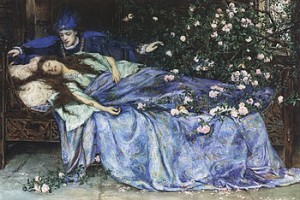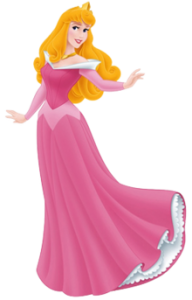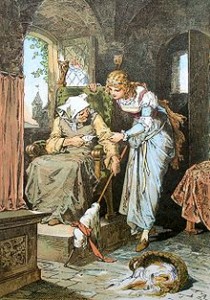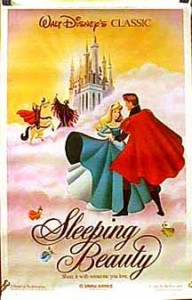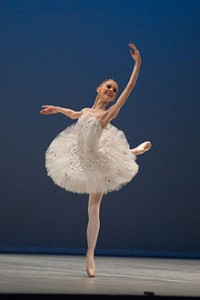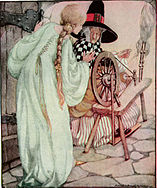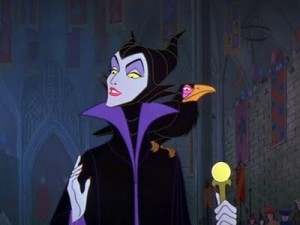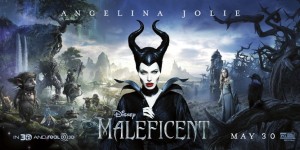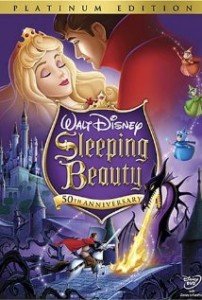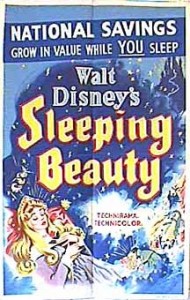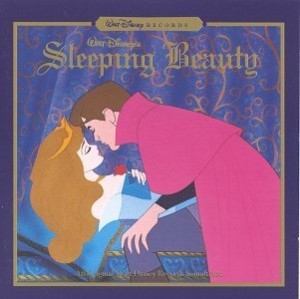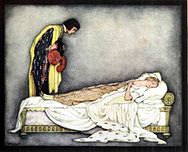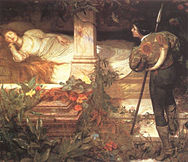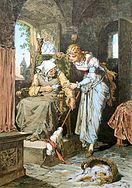Sleeping Beauty **** (1959, voices of Mary Costa, Bill Shirley, Eleanor Audley, Verna Felton, Barbara Luddy, Barbara Jo Allen) – Classic Movie Review 1249
Mary Costa provides the voice of the Princess Aurora in Walt Disney’s hugely imaginative and entertaining 1959 cartoon retelling of the classic French fairy tale La Belle au bois dormant (The Sleeping Beauty) by Charles Perrault. And it is also based also on Little Briar Rose by The Brothers Grimm. The 16th film in the Walt Disney Animated Classics series, it was released by Buena Vista in cinemas on January 29 1959.
Princess Aurora is cursed by snubbed malevolent fairy Maleficent (voice of Eleanor Audley), the evil fairy, who turns up uninvited and her christening and declares that before Aurora reaches her 16th birthday she will die by pricking her finger on the spindle of a spinning-wheel. But the good blue fairy Merryweather (Barbara Luddy) weakens the curse, so that instead of dying, Aurora will fall into a deep sleep from which she can only be awakened by true love’s kiss.
Directed by Les Clark, Eric Larson and Wolfgang Reitherman under the supervision of Clyde Geronimi, it is a magical animated adventure with a powerful, dynamic version of the story, effective songs and score by George Bruns, and one of the studio’s most fearsome creations, the gigantic dragon that Maleficent transforms herself into in order to battle Prince Phillip (voice of Bill Shirley) at the film’s climax.
The film’s musical score and songs, featuring the work of the Berlin Symphony Orchestra, are arrangements or adaptations of numbers from the 1890 Sleeping Beauty ballet by Pyotr Ilyich Tchaikovsky.
The exciting dramatic highlights of the film include the forest of thorns created from lightning bolts, the evil fairy’s transformation into the towering dragon, and the dramatic final conflict as Prince Phillip saves the day and of course enters the palace and goes up the highest tower to awaken Aurora with a kiss. It’s no spoiler to say that Princess Aurora and Prince Phillip live happily ever after.
The 16th film in the Walt Disney Animated Classics series. it’s one of the artistic highlights of the first wave of Disney animation triumphs. Then as now with Disney, time and money were no object. Seven years and ($6million) were lavished on the project.
The story adaptation is by Erdman Penner, and six further people are credited for the screenplay: Joe Rinaldi, Winston Hibler, Bill Peet, Ted Sears, Ralph Wright and Milt Banta.
Shot in 70mm and with a full stereo soundtrack, Sleeping Beauty was a technical triumph and represented a huge advance in its day. It was the first animated film to be photographed in the Super Technirama 70mm widescreen process and the second full-length animated feature film to be filmed in anamorphic widescreen, after Disney’s Lady and the Tramp four years earlier. It was shown in Super Technirama 70 format with six-channel stereophonic sound in its first-run engagements.
It was the last Disney adaptation of a fairy tale for some years because of its initial disappointing box office – it earned only $7.7 million in 1959, little more than its cost – and its mixed critical reception. The studio finally returned to the genre with the release of The Little Mermaid in 1989 after Walt Disney died.
Sleeping Beauty was re-released again and again in cinemas – in 1970, 1979 (in 70mm six-channel stereo, as well as in 35mm stereo and mono) 1986 and 1995. Eventually it has notched up a lifetime gross of $51,600,000 – that’s $478,220,000 in the US and $606,800,000 worldwide, adjusted for inflation, turning a box officer loser into a winner.
Remade as a live-action movie, Maleficent, in 2014 with Angelina Jolie in the title role.
http://derekwinnert.com/maleficent-2014-angelina-jolie-movie-review/
(C) Derek Winnert 2014 Classic Movie Review 1249
Link to Derek Winnert’s home page for more film reviews: http://derekwinnert.com/


